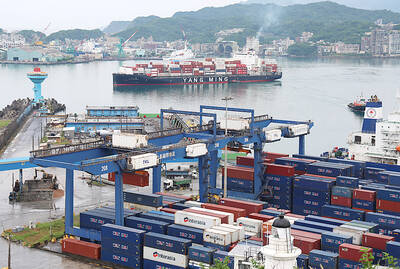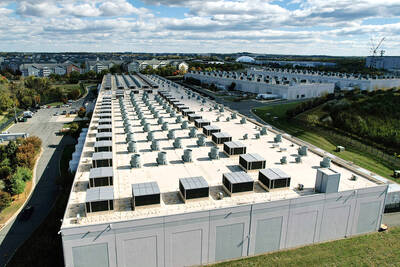The Chung-Hua Institution for Economic Research (CIER, 中華經濟研究院) yesterday revised downward its forecast for Taiwan’s economic growth next year to 3.59 percent from the forecast of 4.29 percent it made in July.
The Taipei-based think tank also cut its GDP growth forecast for the nation this year from the 2.36 percent it forecast in July to 1.52 percent, the fifth straight time it had revised downward the forecast since July last year.
“Under the current conditions, the nation’s economy should have bottomed out in the third quarter, with the momentum likely to rebound in the fourth quarter,” CIER president Wu Chung-shu (吳中書) said at a press conference.
The institute’s quarterly report showed GDP may rise 1.42 percent in the third quarter, followed by a 4.26 percent expansion in the fourth quarter.
As for next year, the think tank expected the economy to be more balanced, with the contribution from domestic demand strengthening compared with that from external demand.
Taipei-based Standard Chartered Bank economist Tony Phoo (符銘財), who also attended the press conference, said the retail industry may be the major driver boosting domestic demand-related sectors next year.
Phoo added that domestic demand driven by the retail industry would likely contribute significantly to the nation’s economy next year.
Retail industry sales usually account for less than 40 percent of the nation’s exports, but have been climbing to more than 40 percent over the past two years, reflecting the strong performance of the industry, Phoo said.
Phoo added that the continuously strong performance of the tourism sector could in turn help boost sales in the retail industry.
The institute’s forecast for next year was generally in line with Phoo’s views.
In the next year, the retail industry is expected to post about NT$4 trillion (US$136.57 billion) in sales, with exports set to stand at about US$320 billion, its data showed.
The think tank forecast private consumption would rise 2.76 percent next year, up from the 2.12 percent growth recorded this year, the report said.
Private investment is expected to climb 6 percent next year, compared with a 2.11 percent contraction this year, the report said.
As for the external sector, the institute estimated exports would grow 6.44 percent next year, from the 1.09 percent drop this year, it said.
On the inflation front, the research institute expected the nation’s consumer price index (CPI) to show 1.97 percent growth this year and further exhibit a 1.59 percent expansion next year, both lower than the 2 percent critical mark.
The Directorate-General of Budget, Accounting and Statistics will update its latest forecast on the nation’s economy and headline inflation on Oct. 31.
In August, the agency estimated GDP would grow 1.66 percent this year, with the headline inflation index expected to rise by 1.93 percent.

Taiwan’s exports soared 56 percent year-on-year to an all-time high of US$64.05 billion last month, propelled by surging global demand for artificial intelligence (AI), high-performance computing and cloud service infrastructure, the Ministry of Finance said yesterday. Department of Statistics Director-General Beatrice Tsai (蔡美娜) called the figure an unexpected upside surprise, citing a wave of technology orders from overseas customers alongside the usual year-end shopping season for technology products. Growth is likely to remain strong this month, she said, projecting a 40 percent to 45 percent expansion on an annual basis. The outperformance could prompt the Directorate-General of Budget, Accounting and

The demise of the coal industry left the US’ Appalachian region in tatters, with lost jobs, spoiled water and countless kilometers of abandoned underground mines. Now entrepreneurs are eyeing the rural region with ambitious visions to rebuild its economy by converting old mines into solar power systems and data centers that could help fuel the increasing power demands of the artificial intelligence (AI) boom. One such project is underway by a non-profit team calling itself Energy DELTA (Discovery, Education, Learning and Technology Accelerator) Lab, which is looking to develop energy sources on about 26,305 hectares of old coal land in

Netflix on Friday faced fierce criticism over its blockbuster deal to acquire Warner Bros Discovery. The streaming giant is already viewed as a pariah in some Hollywood circles, largely due to its reluctance to release content in theaters and its disruption of traditional industry practices. As Netflix emerged as the likely winning bidder for Warner Bros — the studio behind Casablanca, the Harry Potter movies and Friends — Hollywood’s elite launched an aggressive campaign against the acquisition. Titanic director James Cameron called the buyout a “disaster,” while a group of prominent producers are lobbying US Congress to oppose the deal,

Two Chinese chipmakers are attracting strong retail investor demand, buoyed by industry peer Moore Threads Technology Co’s (摩爾線程) stellar debut. The retail portion of MetaX Integrated Circuits (Shanghai) Co’s (上海沐曦) upcoming initial public offering (IPO) was 2,986 times oversubscribed on Friday, according to a filing. Meanwhile, Beijing Onmicro Electronics Co (北京昂瑞微), which makes radio frequency chips, was 2,899 times oversubscribed on Friday, its filing showed. The bids coincided with Moore Threads’ trading debut, which surged 425 percent on Friday after raising 8 billion yuan (US$1.13 billion) on bets that the company could emerge as a viable local competitor to Nvidia